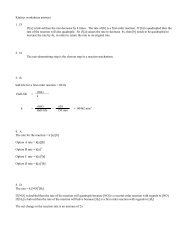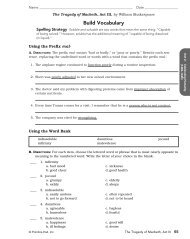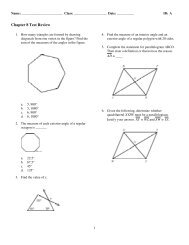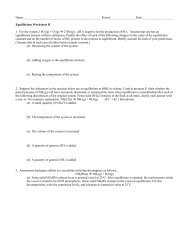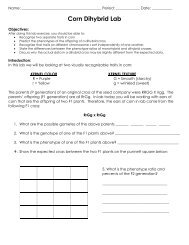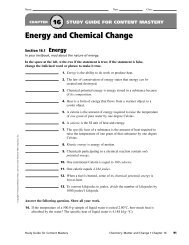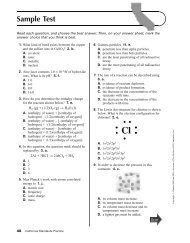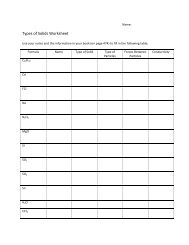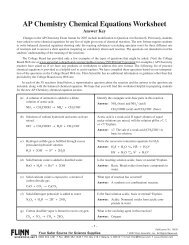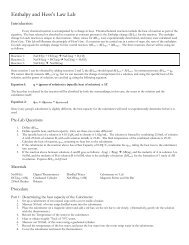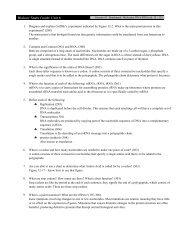intermolecular forces solutions worksheet.pdf
intermolecular forces solutions worksheet.pdf
intermolecular forces solutions worksheet.pdf
Create successful ePaper yourself
Turn your PDF publications into a flip-book with our unique Google optimized e-Paper software.
Name______________________________________________________Period________Date__________________________<br />
Intermolecular Forces and Solutions<br />
_____1. When an electrolyte is dissolved in water to form a solution, the vapor pressure of the solution (compared to pure<br />
water):<br />
a. Increases b. Decreases c. Remains the same d. May either increase or decrease<br />
_____2. Which of the following is most soluble in water<br />
a. SiO 2 b. CH 3 -O-CH 3 c. CaCO 3 d. NaCH 3 CO 2 e. C 6 H 6<br />
_____3. Which of the following will have the lowest freezing point<br />
a. 0.15 M glucose<br />
b. 0.30 M sucrose<br />
c. 0.15 M NaCl<br />
d. 0.30 M CH 3 COOH<br />
e. All the freezing points are equal<br />
_____4. Which of the following will have the highest boiling point<br />
a. 0.25 M NaCl<br />
b. 0.50 M glucose<br />
c. 0.25 M NaCH 3 CO 2<br />
d. 0.50 M MgBr 2<br />
e. All the boiling points are equal<br />
_____5. Ethylene glycol (C 2 H 6 O 2 ) is added to water to make antifreeze. What volume of ethylene glycol must be added to<br />
20.0 L of water to make a solution with a freezing point of -25.0ºC (Density of C 2 H 6 O 2 = 1.11 g/cm 3 . K F of water<br />
= 1.86ºC kg/mol)<br />
a. 15.0 L b. 20.0 L c. 1.50 L d. 12.0 L e. None of the above<br />
_____6. 12.0 g of a non-volatile nonelectrolyte is dissolved in 125.0 g of water. The aqueous solution was found to have a<br />
boiling point of 100.28ºC (at 1 atm). What is the molecular mass of the solute (K b for water equals 0.51ºC kg/mol)<br />
a. 17.5 g/mol b. 5.27 g/mol c. 52.7 g/mol d. 175 g/mol e. None of the above<br />
_____7. Arrange the following compounds in order of increasing melting point based on the relative strength of their<br />
<strong>intermolecular</strong> <strong>forces</strong>:<br />
Cl 2 , SiCl 4 , MgCl 2 , AlCl 3 , NaCl<br />
a. NaCl < MgCl 2 < AlCl 3 < SiCl 4 < Cl 2<br />
b. MgCl 2 < SiCl 4 < Cl 2 < NaCl < AlCl 3<br />
c. Cl 2 < SiCl 4 < AlCl 3 < MgCl 2 < NaCl<br />
d. Cl 2 < AlCl 3 < SiCl 4 < NaCl < MgCl 2<br />
e. MgCl 2 < AlCl 3 < SiCl 4 < NaCl < Cl 2
______8. Arrange the following molecules in order of increasing boiling point:<br />
a. I < II < III b. I < III < II c. II < I < III d. II < III < I e. III < I < II<br />
_____9. Which of these solvents will dissolve the salt NaCl the most<br />
a. Carbon tetrachloride<br />
b. Acetone, (CH 3 ) 2 CO<br />
c. Benzene, C 6 H 6<br />
d. Methanol, CH 3 OH<br />
e. All will dissolve NaCl<br />
_____10. Which of the following substances is NOT likely to exhibit hydrogen bonding<br />
a. CH 3 CH 2 OH<br />
b. CH 3 NH 2<br />
c. HOCH 2 CH 2 OH<br />
d. (CH 3 ) 3 N<br />
e. NH 2 OH<br />
_____11. Helium atoms do not combine to form He 2 molecules, yet He atoms do attract one another through<br />
a. Dipole-dipole <strong>forces</strong>.<br />
b. Ion-dipole <strong>forces</strong>.<br />
c. Dispersion <strong>forces</strong>.<br />
d. Dipole-induced dipole <strong>forces</strong>.<br />
e. Hydrogen bonding.<br />
_____12. Which of the following characteristics indicate the presence of weak <strong>intermolecular</strong> <strong>forces</strong> in a liquid<br />
a. A low heat of vaporization<br />
b. A high critical temperature<br />
c. A low vapor pressure<br />
d. A high boil point<br />
e. None of the above<br />
_____13. Acetic acid has a heat of fusion of 10.8 kJ/mol and a heat of vaporization at 24.3 kJ/mol. What is the expected value<br />
for the heat of sublimation of acetic acid<br />
a. 35.1 kJ/mol<br />
b. –13.5 kJ/mol<br />
c. 15.5 kJ/mol<br />
d. –35.1 kJ/mol<br />
e. Not enough information is given to answer the question.<br />
_____14. Given the following substances and their boiling points, which substance has the strongest <strong>intermolecular</strong> <strong>forces</strong><br />
Hydrogen chloride<br />
Carbonyl fluoride<br />
Carbon monoxide<br />
Methane<br />
-85ºC<br />
-83ºC<br />
-192ºC<br />
-161ºC<br />
a. Hydrogen chloride<br />
b. Carbonyl fluoride<br />
c. Carbon monoxide<br />
d. Methane
Pressure<br />
Liquid<br />
1 atm<br />
Solid<br />
Vapor<br />
0°C 100°C<br />
Energy /<br />
Temperature<br />
_____15. In the mountains, the atmospheric pressure is about 0.8 atm. Which of the following statements is true<br />
a. Water will boil at a temperature higher than 100°C<br />
b. Water will boil at a temperature less than 100°C<br />
c. Water will boil at a temperature of 100°C.<br />
d. Water will not boil.<br />
_____16. Under which of the following conditions will result in ice subliming into steam Assume that at the beginning the<br />
ice is in -2°C at 1atm.<br />
a. Exposing ice to pressure above 1atm at -2°C<br />
b. Exposing ice to temperatures below 0°C at pressure above 5 atm<br />
c. Exposing ice to -5°C at a pressure 0.001 atm<br />
d. None of the above. Water can not under sublimation under any circumstances.<br />
17. A solution is prepared by dissolving 2.75 g of an unknown nonvolatile, nonelectrolyte in water with a volume of 5.00 x 10 2<br />
mL. The boiling point of the solution is 375 K. Calculate the molar mass of the unknown solute. (K b for water equals 0.51ºC<br />
kg/mol) 5pts.



